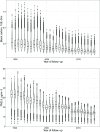Contribution of Long-Term Exposure to Outdoor Black Carbon to the Carcinogenicity of Air Pollution: Evidence regarding Risk of Cancer in the Gazel Cohort
- PMID: 33759553
- PMCID: PMC7989243
- DOI: 10.1289/EHP8719
Contribution of Long-Term Exposure to Outdoor Black Carbon to the Carcinogenicity of Air Pollution: Evidence regarding Risk of Cancer in the Gazel Cohort
Abstract
Background: Black carbon (BC), a component of fine particulate matter [particles with an aerodynamic diameter ()], may contribute to carcinogenic effects of air pollution. Until recently however, there has been little evidence to evaluate this hypothesis.
Objective: This study aimed to estimate the associations between long-term exposure to BC and risk of cancer. This study was conducted within the French Gazel cohort of 20,625 subjects.
Methods: We assessed exposure to BC by linking subjects' histories of residential addresses to a map of European black carbon levels in 2010 with back- and forward-extrapolation between 1989 and 2015. We used extended Cox models, with attained age as time-scale and time-varying cumulative exposure to BC, adjusted for relevant sociodemographic and lifestyle variables. To consider latency between exposure and cancer diagnosis, we implemented a 10-y lag, and as a sensitivity analysis, a lag of 2 y. To isolate the effect of BC from that of total , we regressed BC on and used the residuals as the exposure variable.
Results: During the 26-y follow-up period, there were 3,711 incident cancer cases (all sites combined) and 349 incident lung cancers. Median baseline exposure in 1989 was 2.65 [interquartile range (IQR): 2.23-3.33], which generally slightly decreased over time. Using 10 y as a lag-time in our models, the adjusted hazard ratio per each IQR increase of the natural log-transformed cumulative BC was 1.17 (95% confidence interval: 1.06, 1.29) for all-sites cancer combined and 1.31 (0.93, 1.83) for lung cancer. Associations with BC residuals were also positive for both outcomes. Using 2 y as a lag-time, the results were similar.
Discussion: Our findings for a cohort of French adults suggest that BC may partly explain the association between and lung cancer. Additional studies are needed to confirm our results and further disentangle the effects of BC, total , and other constituents. https://doi.org/10.1289/EHP8719.
Figures



References
-
- Anenberg SC, Schwartz J, Shindell D, Amann M, Faluvegi G, Klimont Z, et al. . 2012. Global air quality and health co-benefits of mitigating near-term climate change through methane and black carbon emission controls. Environ Health Perspect 120(6):831–839, PMID: 22418651, 10.1289/ehp.1104301. - DOI - PMC - PubMed
-
- ANSES. 2019. Particulate matter in ambient air health effects according to components, sources and particle size. https://www.anses.fr/en/system/files/AIR2014SA0156RaEN.pdf [accessed 31 January 2020].
-
- Bein KJ, Zhao Y, Wexler AS, Johnston MV. 2005. Speciation of size-resolved individual ultrafine particles in Pittsburgh, Pennsylvania. J Geophys Res Atmos 110, 10.1029/2004JD004708. - DOI
-
- Beelen R, Hoek G, Raaschou-Nielsen O, Stafoggia M, Andersen ZJ, Weinmayr G, et al. . 2015. Natural-cause mortality and long-term exposure to particle components: an analysis of 19 European cohorts within the multi-center ESCAPE project. Environ Health Perspect 123(6):525–533, PMID: 25712504, 10.1289/ehp.1408095. - DOI - PMC - PubMed
Publication types
MeSH terms
Substances
LinkOut - more resources
Full Text Sources
Other Literature Sources
Medical

